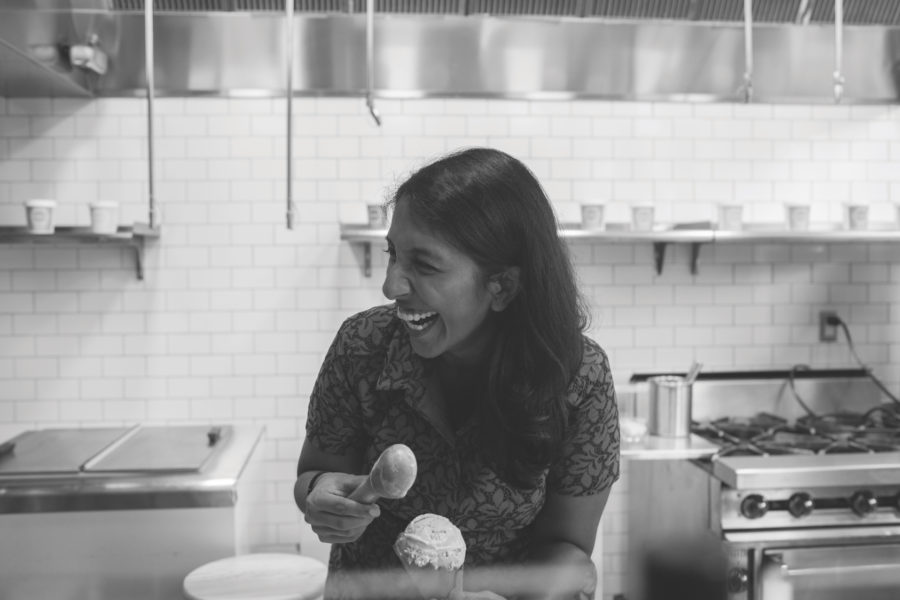The team at OpenTable is excited to be a part of TasteTalks Chicago this weekend, where we’ll be hosting a panel on the white tablecloth revolution and the rise of “upscale casual.” Ahead of the event we spoke to Belinda Chang, James Beard Award-winning sommelier and wine and service director at Maple & Ash in the Windy City. Her experience speaks for itself:
“I’ve pretty much worked this country coast to coast at this point, and I’ve seen a different style of diner region to region,” she says. “I’ve done everything from Charlie Trotter’s — a pretty luxurious price point, serving about 100 people a night — all the way to working with Danny Meyer at The Modern, where we had a bar room where we served hundreds and sometimes thousands of people a day. I spent a few years with Lettuce Entertain you and oversaw a wine program for a fast-casual Chinese concept. The check average there was less than $20.”
Here, Belinda tells us all about the evolution of hospitality, how she trains her service staff, and what makes a truly modern and memorable dining experience (it may or may not involve super-soaker squirt guns). Read on for inspiration.
You started your career in Chicago and came back to join Maple & Ash. What made you want to return to Chicago?
I spent the last eight years in Manhattan, which for a lot of people is the holy grail of the restaurant business. I got a call from Danny Meyer’s crew asking if I knew anyone to oversee the wine program at The Modern and I sent my resume like five minutes later. I got to work with a lot of great people and I was having a great time there.
It was totally coincidental that I was here in Chicago giving a sommelier award and talking to the recipient, Ryan Arnold, who’s a wine director for Lettuce Entertain You, and he said, “You know, it’s maybe time you come home — and I think you know who you should talk to.”
That led to a meeting, and to me packing up my West Village apartment in two weeks and getting my butt over here for this opening at Maple & Ash.
What are you seeing in Chicago right now that you’re really excited about?
We can still do the big restaurant. Here, I’m in a 13,000-square foot restaurant where we serve up to 1,200 people a day. We get a broad and more accurate picture of what the American diner wants compared to some of my counterparts. We get a great mix of locals (people in Gold Coast dine out up to seven nights a week) and we’re steps away from the great hotels in Chicago.
As for trends in Chicago, it’s doing a big box restaurant really well. I love Cheesecake Factory and Ruby Tuesday, but even for that price point, diners want more — real food, stories, real chefs that can be named, the farms their meats and vegetables are coming from. We have a more knowledgeable American diner in general — and wine drinker. I remember going to tables in the ’90s and people were terrified. Now, it’s so much fun because everybody feels more confident in their wine knowledge and wants that to be a fun part of the experience.
And in Chicago, we’re kind of leading the drive in the modernization of the steakhouse. All the great chefs here are taking their stab at that paradigm — there’s this renaissance happening for this iconic restaurant.
Tell me more about that. What are you trying to accomplish today with the steakhouse, and how does that reflect diners’ changing attitudes?
We didn’t necessarily set out to reinvent it. Our owners loved this piece of real estate, and they looked around and said, what does this neighborhood want? It wanted steak. They decided to do a steakhouse they would love to go to every day.
Everybody thought we were ridiculous to open a steakhouse in an ocean of steakhouses. We went for it. What we did differently was, we have the youngest American chef to ever win two Michelin stars. They asked me to run the wine program; at a steakhouse you don’t necessarily need a fancy wine person. They wanted every part of it to not just be great for a steakhouse, but to be awesome for a restaurant. It kind of is a steakhouse but it kind of isn’t. I’ve got verticals of German Riesling on my wine list. We love to do caviar service.
We’re trying to be more thoughtful and make a steakhouse you could go to every day, and that you could also impress your wine-collecting, Michelin star-collecting friend.
What has been your approach to beverage service at Maple & Ash? How have you gone beyond what’s expected?
We don’t want you to feel as if your servers here are mercenaries, as they sometimes can be in steakhouses: you can tell they’re trying to sell you the $100 steak. The first thing we do when you sit down is bring you a free cocktail, shaken tableside, and radishes and butter or fried croquettes. Then you look at the menu. We want it to be this generous, celebratory experience.
I have an army of people on the wine team but we don’t call them sommeliers. I’m one myself, but I hate it. For a lot of people it implies something that is not positive for their dining experience — “here comes the snotty sommelier trying to intimidate me.”
What we have are wine captains. They’re super fun, young, and if you want to drink a $28 bottle of Chilean Sauvignon Blanc they are delighted to bring it to you. It’s not that power-sell moment.
What does that look like from a training perspective — making sure they’re well versed but also that service is casual and approachable?
I tell them that the power downsell is much more effective than the power upsell, which you would never hear in a steakhouse. In other steakhouses they are trained to get the perfect order: the cocktail order, a $200 wine order, a shellfish platter, salads, the steak for two. They actually bonus the servers money when they get the perfect order. We hate that. If you want to come in and have a glass of rose and a wedge salad shared, we’re totally stoked.
For the wine captains, I’m not rewarding them on selling the highest-dollar bottles, I’m rewarding them for making guests happy. We have a weekly one-hour class that I teach that’s not geared towards crushing the guest, it’s geared towards your own personal knowledge. We’ll taste four to six wines together from our list every single week with 30-40 of our staff — even kitchen folks come. Hopefully it keeps them excited to stay with us, because they’re learning.
The theme of our TasteTalks panel is how dining is become more casual overall. How have you observed that throughout your career, and what are you seeing in guests’ expectations now?
Remember when you wanted a French Laundry reservation and you had to call and press redial over and over? The onus was on you to call on the right day to get the reservation on the day you want. I love OpenTable — I’ve used it at every restaurant that I’ve worked in. Not only do we use that, so it’s in their hands and they have the best chance of getting what they want, we also use text messages to confirm. That’s one way we’re responding.
In the experience itself, we don’t tell the guest what we want them to do, it’s about what the guest wants to do. It’s the same with the steps of service: I’ve worked in restaurants where you have all of these people, but only one person is allowed to pour water. These elaborate, structured, fine-dining things are not what diners want today. They want an elevated experience in terms of the ingredients and the wine they’re having, and they want savvy service, but they don’t want stilted, impersonal service at all.
We have a way we evaluate our servers and how they interact with guests called the 51%, which Rich Melman talks about all the time. We call it Maple & Ash Magic. We have two maitre d’s who work the floor, and they’re in charge of driving fun at the tables. You might have a maitre d’ serve you Champagne in a super-soaker squirt gun. I think this is modern — it’s not the kind of stuff somebody buying a fancy bottle of Burgundy used to want, but these days, I think they do.
You might walk into our restaurant one day and there will be a shot luge in the front. We had a girl dressed up as Little Red Riding Hood, shaving truffles onto your risotto. If it makes us laugh, it’s a good thing. We have a list of Maple & Ash moments, and we encourage our staff to continually add to it.
How do you see the relationship between Maple & Ash and Eight Bar? These days operators have to offer a multitude of experiences — how do the concepts play together?
We planned to open a first-floor bar and patio first, and it would be everybody’s introduction to us — the place you really could go every day to go grab your kale salad for lunch, or at 1 a.m. to get a burger to stave off the hangover the next day. But we ended up opening Maple & Ash, which is on the third floor, first.
Maple & Ash is the proper steakhouse menu with all the bells and whistles, and then Eight Bar is burgers and lobster rolls and a foie gras hot dog wrapped in bacon with black truffles. The check average in Eight Bar is less than half what it is on the third floor. We want the service to be the same — celebratory, fun places that are serving the neighborhood — but just in different ways.
Find more tips, inspiration, and fresh ideas for running a restaurant on OpenTable’s Open for Business blog.
This post is sponsored by OpenTable.











